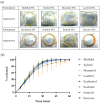3D-Printed Fast-Dissolving Oral Dosage Forms via Fused Deposition Modeling Based on Sugar Alcohol and Poly(Vinyl Alcohol)-Preparation, Drug Release Studies and In Vivo Oral Absorption
- PMID: 36839717
- PMCID: PMC9968038
- DOI: 10.3390/pharmaceutics15020395
3D-Printed Fast-Dissolving Oral Dosage Forms via Fused Deposition Modeling Based on Sugar Alcohol and Poly(Vinyl Alcohol)-Preparation, Drug Release Studies and In Vivo Oral Absorption
Abstract
Three-dimensional printing technology holds marked promise for the pharmaceutical industry and is now under intense investigation. Most research is aimed at a greater efficiency in printing oral dosage forms using powder bed printing or fused deposition modeling (FDM). Oral dosage forms printed by FDM tend to be hard objects, which reduce the risk of cracking and chipping. However, one challenge in printing oral dosage forms via FDM is achieving rapid drug release, because the materials for FDM are basically thermoplastic polymers with slow drug release properties. In this study, we investigated printing a fast-dissolving oral dosage form by adding sugar alcohol to a poly(vinyl alcohol)-based formulation for FDM. Filaments which contain sugar alcohol were successfully prepared, and objects were printed with them as oral dosage forms by FDM. On drug release testing, a printed oral dosage form in a ring shape which contained 55% maltitol showed a more than 85% drug release in 15 min. In vivo oral absorption of this printed oral dosage form in dogs was comparable to that of a conventional fast-dissolving tablet. Of particular interest, the drug release profile and drug amount of the oral dosage forms can be easily controlled by a change in shape using 3D Computer Aided Design. These characteristics will encourage the prevalence of FDM by the pharmaceutical industry, and contribute to the promotion of personalized medicine.
Keywords: PVA; fast dissolving; filament formulation; fused deposition modeling; printed medicine; sugar alcohol.
Conflict of interest statement
Authors Sorato Ikeda, Masanori Kobayashi and Hiroyuki Kojima are employees of Astellas.
Figures








Similar articles
-
Challenges, current status and emerging strategies in the development of rapidly dissolving FDM 3D-printed tablets: An overview and commentary.ADMET DMPK. 2023 Jan 1;11(1):33-55. doi: 10.5599/admet.1622. eCollection 2023. ADMET DMPK. 2023. PMID: 36778904 Free PMC article. Review.
-
[Preparation and in vitro evaluation of FDM 3D printed theophylline tablets with personalized dosage].Beijing Da Xue Xue Bao Yi Xue Ban. 2022 Dec 18;54(6):1202-1207. doi: 10.19723/j.issn.1671-167X.2022.06.024. Beijing Da Xue Xue Bao Yi Xue Ban. 2022. PMID: 36533356 Free PMC article. Chinese.
-
Development of immediate release (IR) 3D-printed oral dosage forms with focus on industrial relevance.Eur J Pharm Sci. 2020 Dec 1;155:105558. doi: 10.1016/j.ejps.2020.105558. Epub 2020 Sep 16. Eur J Pharm Sci. 2020. PMID: 32946957
-
3D printing of pharmaceutical oral solid dosage forms by fused deposition: The enhancement of printability using plasticised HPMCAS.Int J Pharm. 2022 Mar 25;616:121553. doi: 10.1016/j.ijpharm.2022.121553. Epub 2022 Feb 5. Int J Pharm. 2022. PMID: 35131354
-
3D printing hybrid materials using fused deposition modelling for solid oral dosage forms.J Control Release. 2022 Nov;351:444-455. doi: 10.1016/j.jconrel.2022.09.032. Epub 2022 Sep 28. J Control Release. 2022. PMID: 36184971 Review.
Cited by
-
3D Printing Technology as a Promising Tool to Design Nanomedicine-Based Solid Dosage Forms: Contemporary Research and Future Scope.Pharmaceutics. 2023 May 10;15(5):1448. doi: 10.3390/pharmaceutics15051448. Pharmaceutics. 2023. PMID: 37242690 Free PMC article. Review.
-
3D Printing in Oral Drug Delivery: Technologies, Clinical Applications and Future Perspectives in Precision Medicine.Pharmaceuticals (Basel). 2025 Jun 28;18(7):973. doi: 10.3390/ph18070973. Pharmaceuticals (Basel). 2025. PMID: 40732263 Free PMC article. Review.
-
Hot-Melt Extrusion: from Theory to Application in Pharmaceutical Formulation-Where Are We Now?AAPS PharmSciTech. 2024 Feb 14;25(2):37. doi: 10.1208/s12249-024-02749-2. AAPS PharmSciTech. 2024. PMID: 38355916 Review.
-
Practical Application of 3D Printing for Pharmaceuticals in Hospitals and Pharmacies.Pharmaceutics. 2023 Jul 4;15(7):1877. doi: 10.3390/pharmaceutics15071877. Pharmaceutics. 2023. PMID: 37514063 Free PMC article. Review.
-
Customizable Three-Dimensional Printed Earring Tap for Treating Affections Caused by Aesthetic Perforations.Pharmaceutics. 2024 Jan 5;16(1):77. doi: 10.3390/pharmaceutics16010077. Pharmaceutics. 2024. PMID: 38258088 Free PMC article.
References
Grants and funding
LinkOut - more resources
Full Text Sources
Miscellaneous

